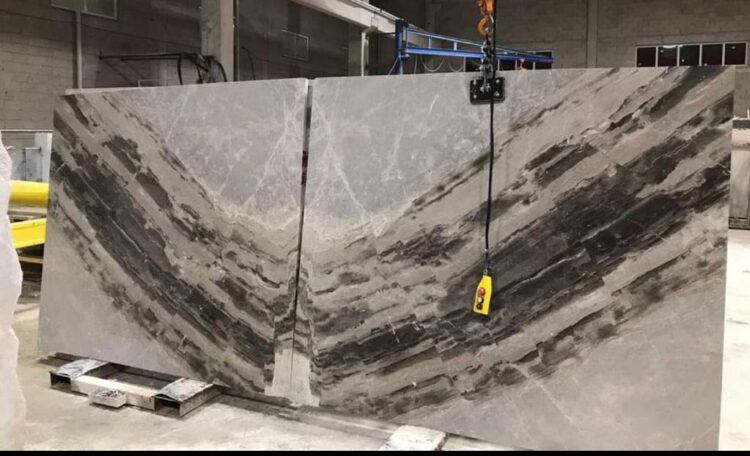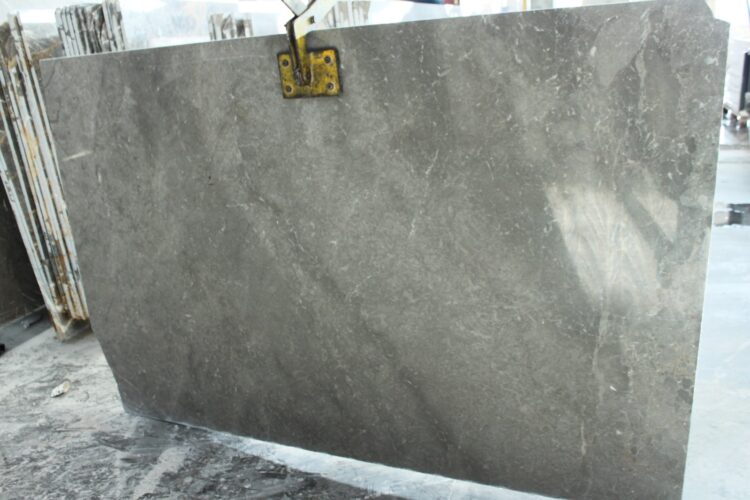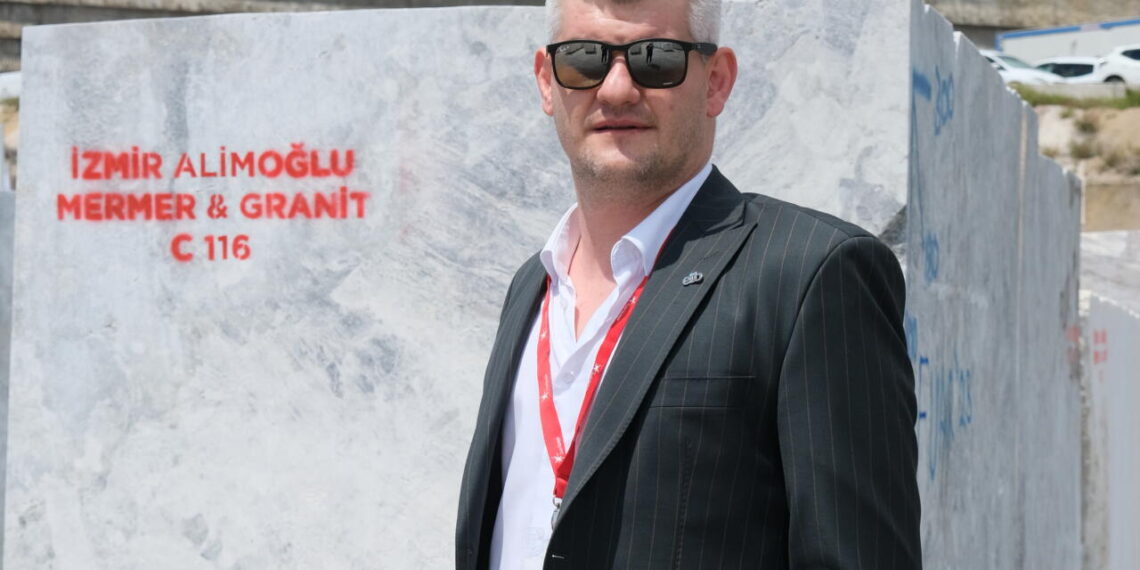Hasan Burak Alimoğlu, CEO of Alimoğlu Marble Granite Ind.and Trade.Inc. Co., is pioneering the utilization of marble residues by taking important steps with sustainability and environmental awareness. In our interview, Alimoğlu emphasized the importance his company attaches not only to its success in the sector, but also to environmentally friendly and eco-friendly practices. This interview, which discusses the economic and environmental benefits of marble waste, reveals the important steps Alimoğlu Marble Granite Ind.and Trade.Inc. Co.has taken not only in the business world but also for a sustainable future.
Could you briefly give information about Alimoğlu Marble company operating in the marble sector?
Alimoğlu Marble Granite Ind.and Trade.Inc. Co.. is a family company whose roots date back to 1940 and whose foundations were laid by Abdullah Alimoğlu. Our company, which started the sector with Natural Stone Quarrying, started factory production with the effect of the machines brought from abroad in the process that developed with the shipment of the stones used in the construction of Anıktabir from our quarries to Ankara, and started exporting with the increase in the export capacity of our country, which is the center of attraction with a considerable proportion of the world’s marble reserves, and has been continuing its activities for about 83 years.
Currently, with its factories and quarries in Izmir, Denizli and Afyon and exports to nearly 25 countries, we continue on our way with the vision of being one of the leading companies in the sector with mass production and project-oriented, customer experience and digitalization.
Can you give information about the types and quantities of residues generated in the marble production process?
Natural stone production is a chained production process in which various residues are formed in the processes starting from the quarry to the production and shipment in the factory. Rubble, dust and paledian residues emerge at these stages. The marble sector, where the amount of waste generated during production and processing is over 90%, releases significant amounts of raw materials for reuse. The resulting residues are divided into two categories: powder and piece residues, which can be utilized in various ways and in different sectors as intermediate goods, semi-finished products and finished products. Although rubble, dust and lump marble residues have different uses, they are mostly used directly as filling material in the construction sector and as a binder of other products used as inputs in the construction sector.
At the end of the mining work carried out in a marble quarry, we can say that with the most optimistic possibility and efficient work, approximately 1% to 3% of the output obtained at the end of the mining work can be obtained as marble, and an amount exceeding 90% consists of slag, rubble and residual material.
How does Alimoğlu Marble evaluate marble waste? Can you give information about recycling and reuse processes?
For many years, we have been offering the residues that are formed in our quarries and factories to the construction industry and ceramic industry as semi-finished products. With efficient production methods, we try to take the necessary precautions even before cutting in the quarry, but of course these are not enough. For this reason, I can say that we have been thinking and developing projects for a long time.
I can say that we now have a recycling product, which we have been working on for about 1.5 years and which we have crowned by receiving the Green Blue Transformation Project Grant from the Izmir Development Agency, which we also call Alimotine (Construction Material Compressed with Water-Based Binders Identical to Nature). Instead of using existing technologies that use chemical-based binding materials such as epoxy and similar chemical-based binding materials that are harmful to the environment, we have turned the rubble, dust and paledyen products, which are the residues of marble operations, into an environmentally friendly construction material that has an economic value after grinding, combining, forming, cutting, wiping and polishing stages by using an environmentally friendly water-based technology. It can be said that an average of 2.5 million tons of marble slag, rubble and residues are formed annually in our business, and about 1,500 tons of marble sludge is formed annually during the production processes. With our Alimonite Project, we aim to separate these residues from the slag, rubble and residue material, which is about 50% of the commercially usable marble output obtained from marble quarries, and bring it into the economy.
One of the most important elements of this project is that, unlike the current artificial marble production based on the use of traditional quartz and marble dust, it has an innovative water-based and environmentally friendly technology that does not use acrylic-based (polyester or epoxy resin) chemicals in its production and the envisaged production method does not harm human health. In this way, the demand for recyclable, environmentally friendly, low carbon emission products in the construction sector, as in many different areas, especially in developed western countries where climate change and environmental protection awareness has increased, will be responded.
Moreover, by launching the pre-product Raw Material, which we have created with Alimonite’s environmentally friendly and nature-identical formula, we will offer it to the use of all mining companies in the sector.
What do you think about the environmental impacts of marble residues and what do you think companies can do to reduce these impacts?
In the mining sector, the most expensive open quarry operation is marble production. One of the most important reasons for this is the necessity of obtaining marble in blocks from the quarry. In our country, marble quarries generally produce large amounts of waste due to low block yields. The fact that the residues resulting from production cannot be utilized in other industrial areas makes these residues, which have accumulated over many years, appear as artificial residue mountains that create visual pollution. Considering the principles of sustainable mining and the 2030 climate action plans, it is urgently necessary to utilize these residues and switch to efficient production methods for less carbon emissions. For sustainable production, we can say that the creation and use of green energy sources, monitoring of product and corporate carbon footprints and planned production are essential.
Besides marble residues, what other steps does Alimoğlu Marble take in terms of sustainability and environmental protection?
We can say that ‘Sustainability’ for Alimoğlu Marble is actually a goal that has been adopted since the very early years with the motto of making production with the awareness of the company’s debt to nature. Considering that the company has a history of playing an active role in NGOs for years, our company always carries environmental awareness on its back like a shirt of nessus.
For sustainability and green energy, a 704 kW Rooftop SPP in our Izmir factory and a 1.3 mW power project with a Land SPP in Afyon have been completed and are already in use. The investment process of our 3rd SPP project in Uşak Eşme is ongoing. In the first quarter of 2024, we aim to use the resources we have in the most accurate way by aiming to provide maximum efficiency with minimum waste with the ‘Digital Production Tracking’ system we will implement.
What are the goals of Alimoğlu Marble in the field of sustainability and environmental protection in the future?
Our investments in Green Energy Resources will continue without slowing down and I can state that we are moving very fast in this area. Our investments in digitalization and the correct evaluation of data will continue in 2024. We also attach great importance to water use and waste water utilization projects for sustainability. Our research on these issues continues. As a participant in the Izmir Industrial Symbiosis Project, which is being carried out in cooperation with the Izmir Development Agency and the United Nations Development Program (UNDP), we continue to support the implementation of the project.
We closely follow today’s technology trends, not only in our own sector, but also in cooperation with other sectors, by conducting studies on doing business together and developing utility models with a focus on Entrepreneurship and Innovation. With these studies, we want to prepare our company for the new world by following the mega trends in the world and to make it more environmentally friendly, more sustainable and more agile.






















 +90 532 585 51 95
+90 532 585 51 95 +90 532 585 51 95
+90 532 585 51 95